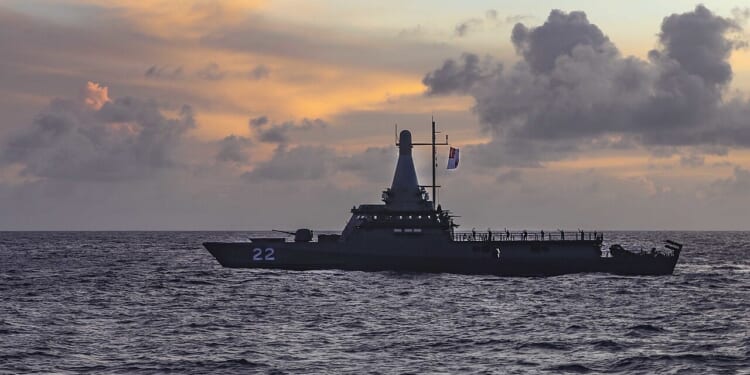By having such a unique and advanced warship at its disposal, the Singaporean Navy will be punching well above its weight in the Indo-Pacific.
Great power competition is now defining every aspect of Southeast Asian geopolitics. A region that was, until recently, a relatively demilitarized zone that concentrated on trade rather than military buildups is now becoming increasingly defined both by trade and militarization.
And it isn’t just the bigger players of the region that are getting into the race for military supremacy. It’s the smaller ones, too.
Possibly the smallest of them all—the city-state of Singapore—is developing an entirely new class of warship, the Victory-class Multi-Role Combat Vessel (MRCV), for its navy to better protect its interests in a region that is becoming pulled apart by the growing Sino-American rivalry.
The Victory-Class MRCV’s Specifications
- Year Commissioned: Not yet commissioned
- Number Built: 1 (6 ordered)
- Length: ~150 m (492 ft)
- Beam (Width): ~21 m (69 ft)
- Displacement: ~8,000 tons
- Propulsion: Integrated Full Electric Propulsion (IFEP) system (30 MW)
- Top Speed: ~22 knots (25.3 mph, 40.7 km/h)
- Range: 7,000 nautical miles (8,055 mi, 12,964 km); 21 days’ endurance
- Armaments: 76mm guided gun, 30mm remotely controlled weapon system, surface-to-air missile systems, surface-to-surface missile systems
- Crew: Less than 100 personnel (baseline configuration)
This warship is built by ST Engineering in Singapore, in partnership with defense technology agencies (the Defense Science and Technology Agency, DSTA and DSO National Laboratories) as well as with international partners, consisting of Saab Kockums of Sweden, Odense Maritime, Technology of Denmark.
Understanding Singapore’s New MRCV Warship
The MRCV is the name of the new class of warship for the Republic of Singapore Navy (RSN). It will replace Singapore’s older missile corvettes.
In typical Singaporean fashion, the warship brilliantly innovates. From its outset, the Victory-class is designed to be a mothership for unmanned systems that will operate air, surface, and even underwater unmanned vessels, while possessing substantial combat capabilities.
In March 2023, the contract for detailed design and construction of six MRCVs was awarded. Outfitting, systems integration, and sea trials are set to begin. Between now and 2028, the Victory-class MRCVs will be progressively delivered to the RSN. Seeing as the new Victory-class MRCV is replacing the old Victory-class corvettes, the new warships will retain the names and pennant numbers of their retiring predecessors. Singapore’s RSS Victory is the namesake of this new class, and she was launched on October 21, 2025, by the RSN.
Singapore’s maritime security depends upon sea lines of communication (SLOCs). The MRCV is explicitly designed to enhance the RSN’s ability to operate farther from home water than any of their previous warships, with unmanned systems providing expanded domain awareness.
The previous iteration of corvettes for the RSN have served since the late 1980s and 1990s.
Because the MRCV is such a long-time coming for the RSN, there are some real technological leaps embedded within the design of the new warship. This new warship incorporates digital-twinning, modular mission bays, advanced radar and sensor suites, along with the manned-unmanned teaming mentioned above.
By having such a unique and advanced warship at its disposal, the RSN will be punching well above its weight in the Indo-Pacific. MRCVs will give the RSN greater presence, flexibility, and interoperability with larger navies in the region.
The MRCV Has Weaknesses, Too
As with any advanced warship program, integration of unmanned systems and other new technologies (such as cyber-secure networks and new sensor/weapon fusions) will be complex and may involve delays and, therefore, cost increases.
What’s more, operational doctrine and crew training will need to adapt to maximize the “mothership” role (such as managing a fleet of unmanned vehicles alongside the mothership might require new organizational and tactical concepts).
Beyond these considerations, the current geopolitical competition in the Indo-Pacific is intense (and intensifying). The new Singaporean MRCVs will need to integrate seamlessly with other RSN and Singaporean Air Force (SAF) allied platforms effectively.
Nevertheless, the fact that the Singaporeans are going all-in with this expensive and complex new warship proves how serious the military competition in the region is getting. And Singapore’s government is smart to do this.
After all, despite its small size, the city-state has many interests in the region and is very reliant on trade across an ocean that is becoming more contested by bigger countries. To stay competitive and secure Singapore’s interests, it will need these new warships.
About the Author: Brandon J. Weichert
Brandon J. Weichert is a senior national security editor at The National Interest. Recently, Weichert became the host of The National Security Hour on America Outloud News and iHeartRadio, where he discusses national security policy every Wednesday at 8pm
Eastern. He is also a contributor at Popular Mechanics and has consulted regularly with various government institutions and private organizations on geopolitical issues. Weichert’s writings have appeared in multiple publications, including The Washington Times, National Review, The American Spectator, MSN, The Asia Times, and others. His books include Winning Space: How America Remains a Superpower, Biohacked: China’s Race to Control Life, and The Shadow War: Iran’s Quest for Supremacy. His newest book, A Disaster of Our Own Making: How the West Lost Ukraine is available for purchase wherever books are sold. He can be followed via Twitter @WeTheBrandon.
Image: Wikimedia Commons.


















